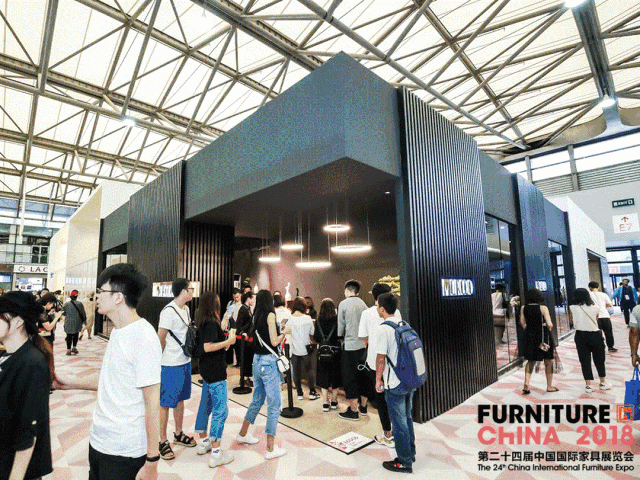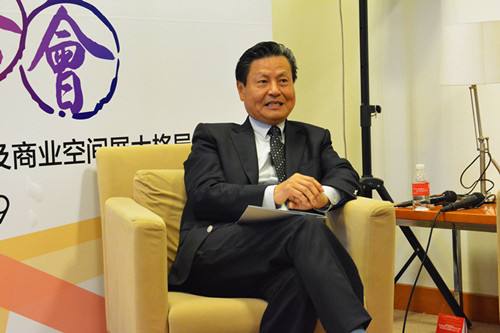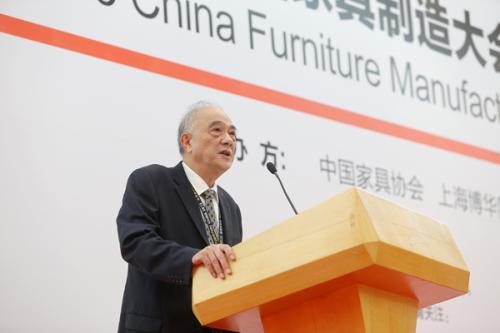What's the Situation of China Furniture Trade Market?
Dialogue with Wang Mingliang, Founder of Furniture China, Dr. Xu Meiqi, Chief Editor of Furniture Magazine, Deputy Director of Shanghai Furniture Research Institute...
On September 14th, the 24th China International Furniture Expo & the 3rd Maison Shanghai hosted by China National Furniture Association and Shanghai UBM Sinoexpo International Exhibition Co. Ltd. ended successfully in Pudong, Shanghai.
In 4 days, the total number of visitors to the exhibition reached 166,479, an increase of 9.28% over the previous year. Among them, the number of overseas visitors reached 21,218, an increase of 23.87% over the previous year.

In the current Sino-US trade friction is in the hot stage, the number of US buyers is not decreasing - the record of innovation for buyers and viewers, up to 1929 people, an increase of 803 people increased by 71% compared with 1126 people last year.
After the Expo, Mobile, a brazilian media made an interview to the founder of Furniture China and Maison Shanghai, Mr.Wang Mingliang, and Dr.Xu Meiqi, Chief Editor of Furniture Magazine, Deputy Director of Shanghai Furniture Research Institute to Share their opinions about the China furniture trade market situation.


Mr.Wang Mingliang and Dr.Xu Meiqi
Q1: How the strength of the Chinese furniture industry is linked to the growth of the Chinese economy in this century?
Mr.Wang Mingliang: China witnessed high growth in the last 40 years since open door policy. Its GDP growth had been continuously over 10 percent, until last few years reduced to 6.5 percent. China’s furniture industry growth used to be higher then GDP growth, because China’s furniture serves both for domestic and overseas markets.
Dr. Xu Meiqi: There is an intensive positive correlation between the national economy and domestic furniture industry. Since the reform and open in China, the gross domestic product per capita was USD8827 in 2017 from USD318 in 1990. The development of Chinese economy makes the people to significantly raise their life level and at the same time, the people have extreme enthusiasm and desires to enhance the qualities of the life, which have obviously resulted in the more rapid pace than the pace of the GDP.
Conclusion: The development of China's furniture industry and China's economic development are mutually reinforcing.
Q2: What is the strategy of the Chinese furniture industries to became the largest producer and exporter of furniture in the world?
Mr.Wang: China’s furniture industry is almost 100% driven by the private sectors. So it is hardly say any strategy in the past. The market demand driven by the needs of people’s living standard, and quality vs price competitiveness driving China being the fastest growing and become the world biggest furniture producer. Furniture China exhibition one way or another helped the industry to change, as a strategy to focus on quality and creative designs after world economic crisis in 2008. China is no longer a country to provide cheap furniture, as the labor. OST is much higher then used to.
Dr. Xu: Chinese furniture industry adopts the development strategy of domestic demands being the dominance with export as complement. But, because China is the biggest population in the world which have huge domestic market, the output of Chinese furniture industry is the biggest. In the initial and middle stages of the reform and open in China, Chinese government adopted the economic strategy of export oriented in addition to the shift to China from international furniture industries, China became the biggest country of furniture exportation. But, Chinese furniture industry needs the adjustment of the development strategy and turns to adopt the original development strategy of domestic demands being the dominance with export as complement from now on.
Conclusion: Domestic demands being the dominance with export as complement.
Q3: Has investment in machinery and technology helped to boost the Chinese furniture industry? What was the government's support in this regard?
Mr.Wang: As I said government do not care about the furniture industry as they are all cared by private companies themselves. For furniture industry in China, it is both depending on labor and machinery. It had been in the last two decade that changes take place that labor is less while machinery more. Some of the factories now using more and most up to date technology machinery to equip their workshops. The Chinese government put serious pressure to furniture manufacturers for anti environment pollution solutions, so it is obvious China now enter into a new era that technology are more important to keep China’s furniture industry remain competitive.
Dr. Xu: Since the reform and open, there are big progresses in woodworking and cabinet-making machinery in China, for examples, there are huge scale of woodworking machinery industry in Lunjiao in Guangdong, Qingdao and Yantai in Shandong, Shanghai and Jiangsu Province. In brief, as the essence of the second industry revolution is the mass production of the machines by the machines, China is going to finish the second industry revolution, the related machinery and hardware industry for making furniture should be taken great efforts to develope in China.
Conclusion: Technology are more important to keep China’s furniture industry remain competitive.
Q4: What is the business model used by these industries? How, in your opinion, can the Brazilian furniture industry be “make the same” in this case?
Mr.Wang: It is a difficult question. Each country has its own advantage and disadvantage in their industries. Brazil is rich of timber and closer to North and South America, Chinese people are more entrepreneurs who are aggressive seeking for success. I don’t know the correct answers, probably Brazil need more entrepreneurs.
Dr. Xu: Most enterprises in Chinese furniture industry and woodworking industry are private-owned companies, few state-owned enterprises. They adopt the business model is market-oriented, that is, to provide the products with good cost performance for consumers. I think, this business model is the model with universal value, which is also fit for Brazilian furniture industry.
Conclusion: Market-oriented.
Q5: How the design of the Chinese furniture collaborate for this scenario? Chinese companies have created furniture with authorial design? How did it happen?
Mr.Wang: The market change drives China’s manufacturers to do their own creative designs with Chinese and Overseas designers, especially for big companies. Chinese government now push hard for industries to seriously abide by Intellectual properties. When you visit Furniture China 2018 in Shanghai in Sept. you will see how fast China have change their design oriented presentation of Verizon’s furniture products.
Dr. Xu: Now, the life-style of Chinese consumers is modern in which, they aspire to individualization and fashion more and more. Therefore, the design of furniture pays more attention to the demands of individualization and fashion. But, the furniture with the elements of Chinese traditional culture are a great favourite with Chinese consumers now, then the so called “neo-Chinese style” furniture emerges as time requires, which has been adopted by the elements of Chinese traditional culture in the form and decoration. The design of Chinese furniture is being explored and developed and no authorized design is identified with all consumers. I think it will undergo a very long time to establish a stable style of Chinese furniture.
Conclusion: The design of Chinese furniture is being explored and developed.
Q6: What is the relationship of the industry with China's furniture retail? And the other retail of Asia?
Mr.Wang: Specialized furniture malls dominated China’s furniture retails in the past 3 decades. However, online retails by Alibaba and Jindong channels are now quickly draw away young buyers from traditional channels of retails habit. Gradually, China market driving retails to different ways of online and offline retails.
Dr. Xu: The furniture retail industry in China is the furniture shopping mall. The most retailers purchase the furniture from the furniture manufacturers and sale in their booth of furniture shopping mall or the manufacturers rent the booths from the owners of the furniture shopping mall to sale their own products. Most furniture shopping mall don’t directly engage the business of furniture sale. Their jobs are estate management. Many countries in Asia such as Singapore operate with this business mode of furniture retail.
Conclusion: Online retails and furniture shopping mall take more importances.
Q7: What is the trend of Chinese furniture in the national and international scenario?
Mr.Wang: As China furniture manufacturers are private owned, they can. Rey quickly adapt to the market changes, some of the factories may shut down, some are investing to have more market share. At the moment, the US tariffs will affect China’s export. The industry is facing the time of Washington cards. China will no longer be a country of fast growing by quantities, but by quality and design.
Dr. Xu: Based on the domestic and international market, Chinese furniture industry must continue to raise market competition forces which embody in strengthen self-dependent innovation design, raising labor productivity and cut off the cost of production. In the field of furniture design, the modernization of Chinese furniture should be realized by the way of Chinese style; the aim of raising labor productivity should be achieved by the use of digit manufacturing technology; the modernization of business management should be come true by collaborative manufacturing model.
Conclusion: China will no longer be a country of fast growing by quantities, but by quality and design.
Q8: What is the importance and relevance of Furniture China and Ciff Shanghai, which occur in the same week, within the world furniture market?
Mr.Wang: Furniture China used to be export oriented, and its still the main attraction by both exhibitors and international buyers. Since year 2008, Furniture China put high end and original design as the 2nd importance to develop the show unique that no other furniture shows can be the same as Furniture China. We don’t see CIFF a threat now. CIFF is different, which exhibitors and visitors choose their preference.
Dr. Xu: CIFF is the hub or tie of connecting Chinese furniture industry with the international furniture industries. Every part of industry chain should be collaborated and interacted, which will promote the development of Chinese furniture industry.
Conclusion: Furniture China export oriented with high end and original design.
(Source: JJgle.com)

 沪公网安备31010402003309号
沪公网安备31010402003309号



